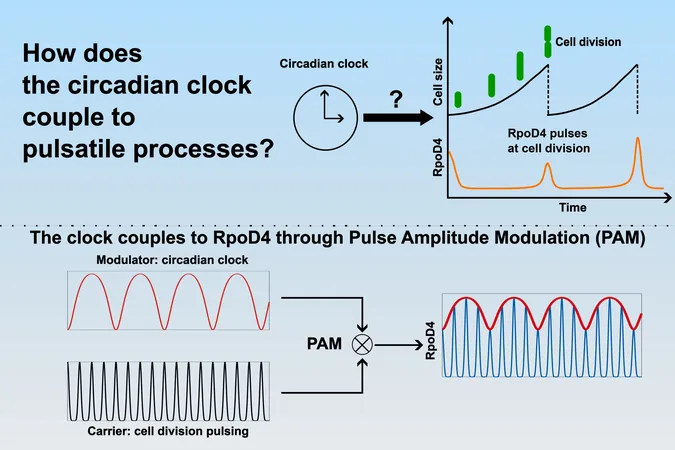
Unveiling the Secrets of Cyanobacteria: How an Ancient Microbe Uses AM Radio Principles to Regulate Life
2024-11-25
Author: Sarah
Introduction
Cyanobacteria, often referred to as blue-green algae, have revealed extraordinary capabilities that resemble the mechanisms used in AM radio transmission. This groundbreaking insight gives us a peek into how these ancient microorganisms, which have existed for over 2.7 billion years, manage vital cellular processes through the remarkable use of physics.
Recent Study Findings
A recent study published in Current Biology has highlighted that these remarkably adaptable bacteria utilize variations in pulse amplitude—the strength of signals over time—to manage their genetic activity. This thrilling discovery is not just an academic whim; it has profound implications for our understanding of circadian rhythms and cellular activities.
AM Radio Principles
In the world of AM radio, information is conveyed through two primary elements: a constant 'carrier wave' acts as a foundation, while the audio signal—whether it's music or speech—is superimposed on this carrier through amplitude modulation. By tweaking the strength of the carrier wave, critical information can be transmitted effectively.
Cyanobacteria's Mechanism
Professor James Locke from the Sainsbury Laboratory Cambridge University and Dr. Bruno Martins from the University of Warwick led a team to uncover that a similar strategy is harnessed by cyanobacteria. Their study revealed that these bacteria's cellular division cycles provide the “carrier signal,” while their intrinsic 24-hour circadian clock creates the modulating signal, effectively syncing the two processes, which operate at different frequencies.
Biological Rhythms and Communication
This blend of biological rhythms is essential for understanding cellular communication and resilience in varying environments. The research utilized advanced techniques, including single-cell time-lapse microscopy and mathematical modeling, to analyze the behavior of a pivotal protein called RpoD4, which is vital for transcription—the process where DNA is converted into RNA.
Findings on RpoD4 and Circadian Influence
The revelation that RpoD4 pulses align precisely with cell division cycles, driven by circadian influences, unlocks potential answers to longstanding questions in cellular biology. Dr. Chao Ye, the lead author, emphasized the significance of these findings, explaining how the circadian clock governs the strength of pulses, adeptly encoding information from both the cellular and circadian cycles.
Manipulating External Factors
Interestingly, the research showcases that manipulating external factors, like ambient light or genetic mutations, can alter the frequency of these cycles, validating the principle behind this natural phenomenon. Dr. Martins noted the elegance found in nature, reflecting principles that are frequently associated with human engineering.
Implications for Future Research
The implications of this discovery extend beyond mere academic interest. Professor Locke stated that understanding the fundamental circadian mechanisms in simple organisms like cyanobacteria could pave the way for advancements in more complex life forms, including crops and humans. This knowledge could potentially revolutionize synthetic biology and biotechnology, leading to resilient crops capable of thriving under shifting environmental conditions—essential for the future of sustainable agriculture.
Conclusion
Thus, while cyanobacteria might appear unassuming in their natural habitats, their complex coordination of cellular processes offers us profound insights into the essential rhythms of life. The next time you tuning into your favorite radio station, ponder the biological harmonies playing out beneath your feet!

 Brasil (PT)
Brasil (PT)
 Canada (EN)
Canada (EN)
 Chile (ES)
Chile (ES)
 España (ES)
España (ES)
 France (FR)
France (FR)
 Hong Kong (EN)
Hong Kong (EN)
 Italia (IT)
Italia (IT)
 日本 (JA)
日本 (JA)
 Magyarország (HU)
Magyarország (HU)
 Norge (NO)
Norge (NO)
 Polska (PL)
Polska (PL)
 Schweiz (DE)
Schweiz (DE)
 Singapore (EN)
Singapore (EN)
 Sverige (SV)
Sverige (SV)
 Suomi (FI)
Suomi (FI)
 Türkiye (TR)
Türkiye (TR)